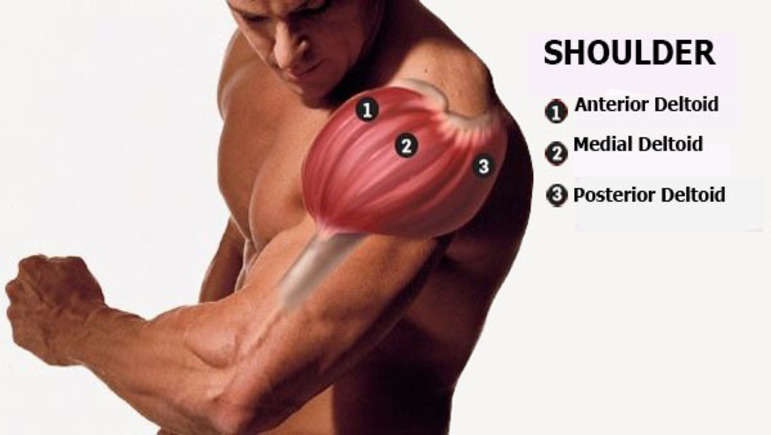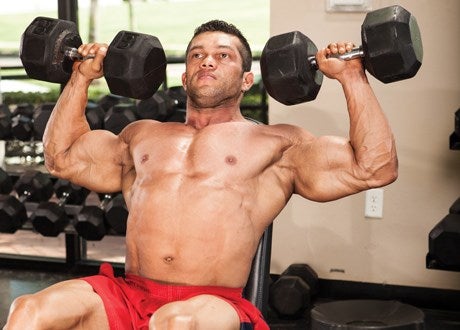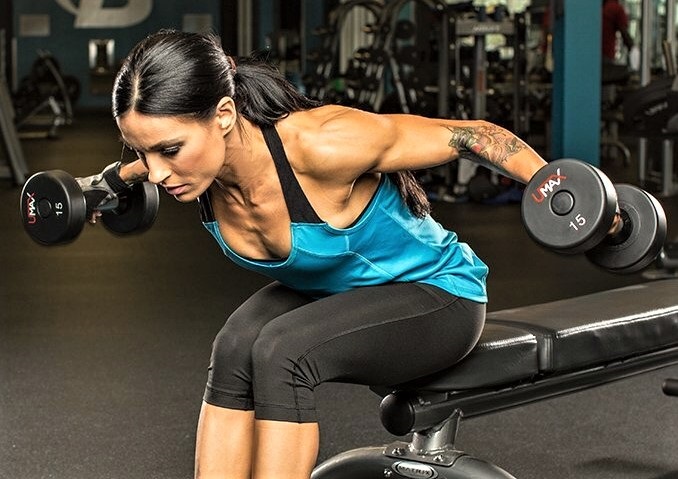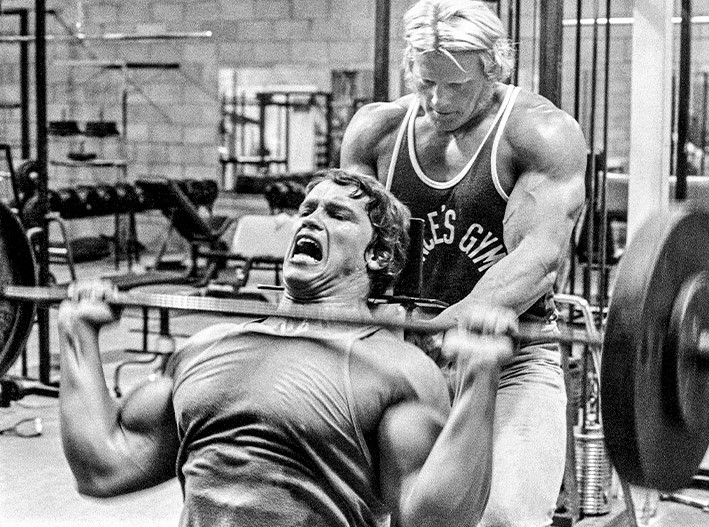These are the best shoulder exercises. Shoulders are complex. Working with ball and socket joints, your deltoids have a lot to do, moving your arms up, forward, outward, and backward. Your trapezius also has multiple jobs, pulling your scapula up and back and moving your neck. For this reason, no one exercise does a good job of training your complete shoulders. In fact, when we break your shoulders into four areas, it’s difficult to find one exercise that effectively hits any two areas. Let’s delve into this and see what the science says about the best shoulder exercises.
SHOULDER ANATOMY
The deltoids are composed of three heads that originate at different points on the shoulder girdle but all converge on one common tendon that inserts on the humerus.

• The anterior deltoid (front) works with the pecs to perform pressing movements, and it lifts the arm up in front of the body.
• The medial deltoid (middle) lifts the arm up out to the sides.
• The posterior deltoid (rear) works with the lats to move the arms backwards.
• The trapezius, a trapezoid-shaped muscle (actually two muscles, left and right) lies like a kite on the back and shoulders. Because the large middle and lower areas function more with the back than the shoulders, we’ll discuss only the upper traps here. The upper traps elevate your shoulder girdle. This area also helps extend, tilt, and rotate your neck.
BEST SHOULDER EXERCISE STUDIES
We’ve focused on three electromyography (EMG) studies, each of which measured deltoid responses to various shoulder and other exercises. There are a lot of shoulder exercises and variations (think of all the ways you can press overhead, for example), so, unfortunately, the studies don’t cover some of the things we wish they did. Also, the two studies with multiple subjects tested many fewer exercises than the study with only one subject (the scientist, himself). So, individually, each has limitations, but together they form a clearer picture.
• EMG study 1: The American Council of Exercise, 2014, 16 men, 7 shoulder exercises, 2 chest exercises, 1 cardio exercise
• EMG study 2: Boeckh-Behrens & Buskies, 2000, 10 men, 7 shoulder exercises, 1 chest exercise
• EMG study 3: Contreras, Bret, 2010, 1 man, 20 shoulder exercises, 4 chest exercises, 3 back exercises
BEST FRONT DELT EXERCISES
Each of the three studies are very clear about one thing: Overhead pressing is best for front delts. The front raise, which isolates the front delts, is an okay exercise to include for variety on occasion. However, pressing rules. In fact, study 3 ranked incline presses well ahead of front raises and studies 2 and 3 ranked bench presses in a virtual tie with front raises, and those are chest exercises. Always include at least one overhead press in your shoulder routine; and, if you choose two exercises for front delts, it’s best to do two types of overhead presses, as opposed to a press and a front raise.
DUMBBELL SHOULDER PRESS
This press ranked #1 and #2 in the two studies that included it. The greater mobility of dumbbells and the need to balance them may give it a slight advantage over barbell military presses. But all overhead presses are recommended.

SEATED BEHIND-THE-NECK PRESS
This is an exercise that shows up on a lot of “worst” or “avoid” lists as a shoulder-wrecker. So, what’s it doing in our top two? Simply put, if performed correctly, it’s not dangerous, and, along with doing a great job of stressing the front delts, it works the middle delts and upper traps more than other overhead presses.
So, here’s how to do it safely. Whether done with a barbell or Smith machine, situate yourself so the bar passes very near the back of your head, even brushing against it, and don’t let it go lower than your mid-ears. (With a Smith machine, you can set the stops to prevent it from going lower.) Respect but don’t fear the BTN press. However, if you have shoulder issues, experience any pain when trying it, or lack sufficient mobility to get full reps, skip it. There are plenty of other machine and free-weight overhead presses to choose.
BEST MIDDLE DELT EXERCISES
Several exercises rated well for medial delts in the three EMG studies, especially those focused more on the rear delts (45-degree incline row, seated rear dumbbell raise, reverse fly, rope face pull). Nevertheless, averaging all three studies, there was a clear winner. Predictably, it’s the side lateral.
SIDE LATERAL RAISE
The dumbbell lateral raise isolates the medial delts. Bend your arms only slightly. Research done in study 2 shows that bending them at 90% reduces the tension on your delts dramatically, even though it allows you to use more weight. The amount of weight is of less concern than increasing the workload on the targeted muscle heads. As you raise the dumbbells up to where your arms are parallel to the floor, tilt your hands so your pinkies are higher than your thumbs. In this way, the middle delts do most of the work. For variety, you can do lateral raises with a single cable, two cables, or a machine.
You can also do top lateral raises. With light dumbbells (30-50% of what you’d use for full reps), do only the upper halves of reps and hold contractions for 2-3 seconds, longer on your last rep. This is a great finisher after doing full reps with heavier dumbbells.
UPRIGHT ROW
The upright row scored only okay for medial delt activation in the two studies that included it. However, it’s also a decent trapezius exercise, and it gives some work to the front and rear delts. So, it’s all around just okay. You may want to include it in your routine occasionally for variety. We advise you do upright rows—with a barbell, Smith machine, or cable—after side laterals to pre-exhaust your side delts and, therefore, focus it more on that area. You also work the side delts more by taking a wider grip (slightly more than shoulder width) as opposed to the narrow grip many trainers use.
BEST REAR DELT EXERCISES
The rear delt winners were various kinds of dumbbell rear lateral raises or reverse flyes. The band face pull ranked highest in study 3, but that’s likely because it was done in a way that mimicked a machine rear lateral, pulling the sides of the band apart vigorously.
REAR LATERAL RAISE
Though the studies didn’t test them all, we suspect that any rear lateral movement, whether with dumbbells (bent-over, seated, or lying face-down on an incline bench), machine, cables, or a band would rank high. So, switch it up for variety. And if you do two rear lateral exercises in the same workout, make one dumbbell and the other mechanical.

45-DEGREE INCLINE ROW
Somewhat surprisingly, in Study 1, the 45-degree incline row ranked highest for medial delts by a close margin and a close second for rear delts. Start face-down on a 45-degree incline bench holding a dumbbell in each hand. Then, keeping your forearms perpendicular, lift the dumbbells while bending your elbows so your upper arms move straight out. Lift your upper arms as high as possible, contracting your scapula at the top.
BEST UPPER TRAPEZIUS EXERCISES
Your traps have a short range of motion, shrugging your shoulders or stabilizing and assisting on other upright pulling exercises, like the upright row, deadlift, or power clean.
SHRUG
No surprise. The shrug is best. But which shrug? Study 3 ranked the barbell shrug above the dumbbell shrug or barbell behind-the-back shrug. But we’d like to see more data than one study with one subject. Also, there’s not a lot of ways to add variety with the shrug, which is pretty vanilla with its limited range of motion. So, we recommend any type of shrug: barbell, dumbbell, machine, cables, or behind-the-back with a Smith machine or barbell. You can also do dumbbell shrugs leaning forward or backward against an incline bench (set at only a slight incline).
For much more on traps training and shrug variations, check out: Traps Workout: Ultimate Training Guide
TOP DEADLIFT
An EMG deadlift study demonstrated what most powerlifters know: Upper trapezius stimulation is greatest at the top of deadlifts. Take advantage of this by doing top deadlifts in a rack with the supports set just above your knees. You can definitely use a lot of weight with this limited movement, so for safety go for at least 10 reps. And this is particularly effective if you pre-exhaust the traps by doing shrugs first.
BEST SHOULDER ROUTINE
We’ve assembled a sample routine with two top-rated exercises for each of the four areas. At first blush it might look like a lot of volume, but it’s actually only 5 sets per area.
Dumbbell Shoulder Press — 3 x 8-12 reps
Smith Machine Behind-the-Neck Press — 2 x 15 reps
Dumbbell Side Lateral — 3 x 10-12 reps
One-arm Cable Side Lateral — 2 x 15 reps
Machine Rear Lateral — 3 x 10-12 reps
45-Degree Incline Row — 2 x 15 reps
Barbell Shrug — 3 x 10-12 reps
Top Deadlift — 2 x 10-12 reps
Related content: How to Get Wider Shoulders
















































